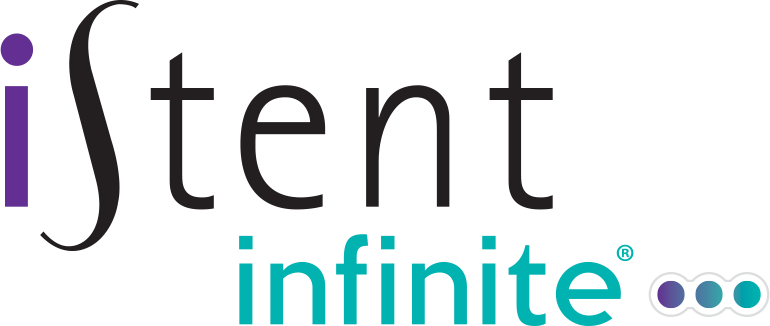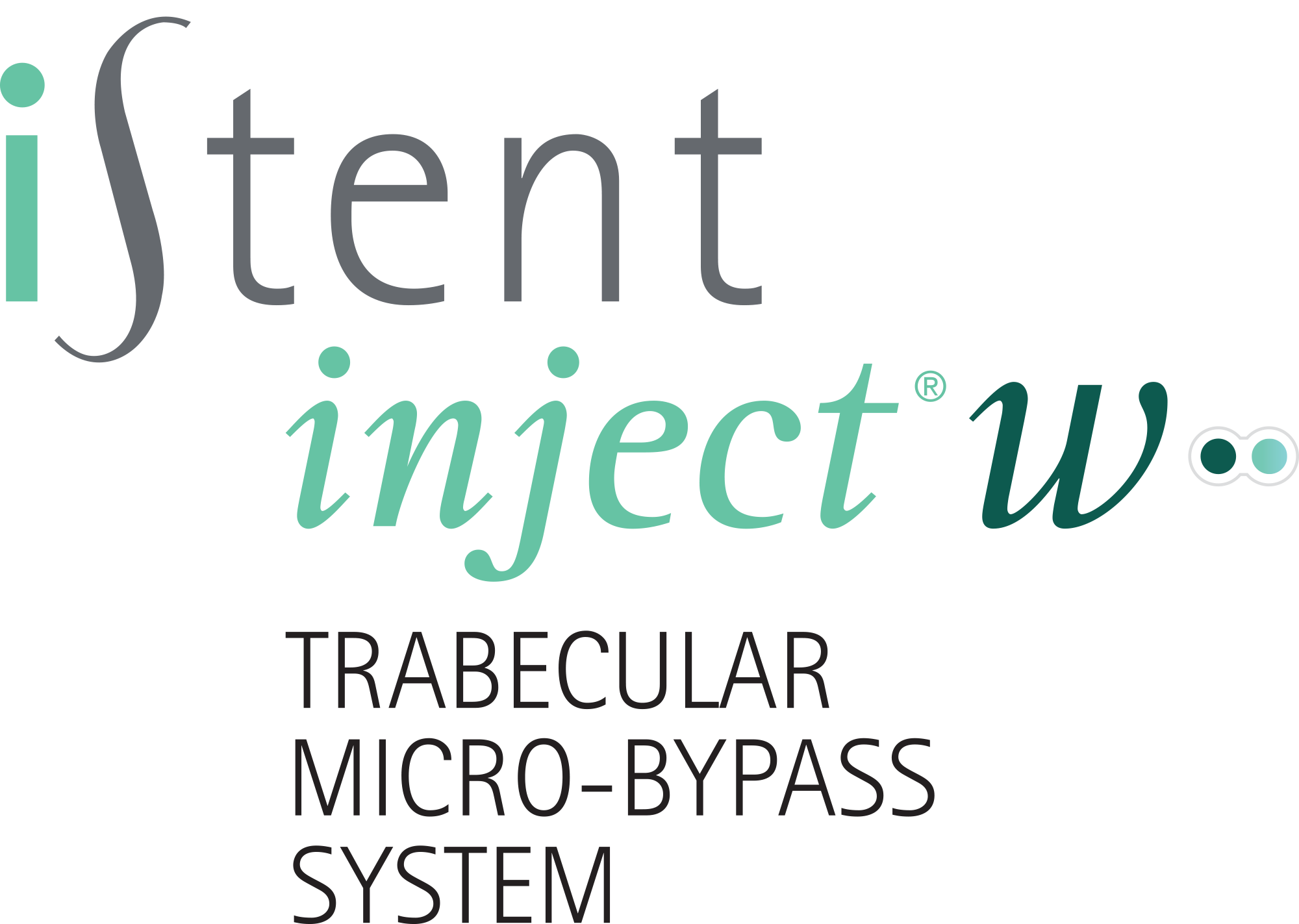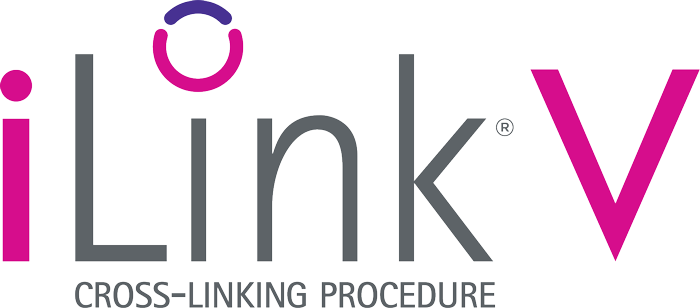
IMPORTANT SAFETY INFORMATION
INDICATION FOR USE The iStent infinite Trabecular Micro-Bypass System Model iS3 is intended to reduce intraocular pressure in adult patients diagnosed with primary open-angle glaucoma (POAG) currently treated with ocular hypotensive medication. The device can be implanted with or without cataract surgery. CONTRAINDICATIONS. The iStent infinite System is contraindicated under the following circumstances or conditions: In eyes with primary angle closure glaucoma, or secondary angle-closure glaucoma, including neovascular glaucoma, because the device would not be expected to work in such situations; In patients with retrobulbar tumor, thyroid eye disease, Sturge-Weber Syndrome or any other type of condition that may cause elevated episcleral venous pressure. WARNINGS. Gonioscopy should be performed prior to surgery to exclude congenital anomalies of the angle, PAS, rubeosis, or conditions that would prohibit adequate visualisation that could lead to improper placement of the stent and pose a hazard. MRI INFORMATION. The iStent infinite is MR-Conditional, i.e., the device is safe for use in a specified MR environment under specified conditions; please see Directions for Use (DFU) label for details. PRECAUTIONS. The surgeon should monitor the patient postoperatively for proper maintenance of IOP. Three out of 61 participants (4.9%) in the pivotal clinical trial were phakic. Therefore, there is insufficient evidence to determine whether the clinical performance of the device may be different in those who are phakic versus in those who are pseudophakic. ADVERSE EVENTS. The most common postoperative adverse events reported in the iStent infinite pivotal trial included IOP increase ≥ 10 mmHg vs. baseline IOP (8.2%), loss of BSCVA ≥ 2 lines (11.5%), ocular surface disease (11.5%), perioperative inflammation (6.6%) and visual field loss ≥ 2.5 dB (6.6%). CAUTION. Please see DFU for a complete list of contraindications, warnings, precautions, and adverse events.

IMPORTANT SAFETY INFORMATION
INDICATION FOR USE. The MicroShunt is intended for reduction of intraocular pressure in eyes of patients with primary open angle glaucoma where IOP remains uncontrollable while on maximum tolerated medical therapy and/or where glaucoma progression warrants surgery. CONTRAINDICATIONS. The implantation of the MicroShunt is contraindicated under the following circumstances and conditions: ANGLE CLOSURE GLAUCOMA; PRESENCE OF CONJUNCTIVAL SCARRING, PREVIOUS INCISIONAL OPHTHALMIC SURGERY INVOLVING THE CONJUNCTIVA OR OTHER CONJUNCTIVAL PATHOLOGIES (E.G., THIN CONJUNCTIVA, PTERYGIUM) IN THE TARGET QUADRANT; ACTIVE IRIS NEOVASCULARIZATION; ACTIVE INFLAMMATION (E.G., BLEPHARITIS, CONJUNCTIVITIS, SCLERITIS, KERATITIS, UVEITIS); SECONDARY GLAUCOMA SUCH AS POSTTRAUMATIC, PSEUDOEXFOLIATION OR PIGMENTARY; VITREOUS IN THE ANTERIOR CHAMBER; PRESENCE OF AN ANTERIOR CHAMBER INTRAOCULAR LENS (ACIOL); INTRAOCULAR SILICONE OIL. WARNINGS. Rx only: This device is restricted to sale by, or on the order of, a physician. For one-time use only. Do not reuse or re-sterilise. Reuse, or re-sterilisation may compromise the structural integrity of the device and/or lead to device failure which, in turn, may result in serious patient injury, illness, blindness or death. Reuse, or re-sterilisation may also create a risk of contamination of the device and/or cause patient infection or cross-infection, including, but not limited to, the transmission of infectious disease(s) from one patient to another. Contamination of the device may lead to injury, illness, blindness, or death of the patient. After use, dispose of product and packaging in accordance with hospital, administrative, and/or local government policy. Long term effects of Mitomycin C (MMC) with the use of this device have not been evaluated. Necessary precautions and interventions on the use of MMC are highly recommended. The patient’s IOP should be monitored postoperatively. If IOP is not adequately maintained after surgery, appropriate additional therapy to maintain IOP should be considered. The MicroShunt should not be subjected to direct contact with petrolatum-based (i.e., petroleum jelly) materials (e.g., ointments, dispersions, etc.). No cutting or modification of the MicroShunt is allowed. POTENTIAL COMPLICATIONS / ADVERSE EVENTS. The complications during and after surgery may include: Glaucoma progression not controlled, increase in cup-to-disc ratio (C/D), anaesthesia related complications, difficulty in inserting the MicroShunt, failure to implant the device, device malfunction, device repositioning, extended surgical procedure, tube migration out of anterior chamber, flat anterior chamber, shallow anterior chamber, excessive bleeding in anterior chamber or incision site or eye, MicroShunt touches cornea or iris, intraocular pressure too high or low, strabismus, viscoelastic used in anterior chamber, choroidal effusion or hemorrhage, retinal complications (retinal detachment, proliferative retinopathy), hyphema, hypotony or hypotony maculopathy, phthisis bulbi, endophthalmitis, tube erosion through conjunctiva, tube obstruction partial or complete (block by iris or vitreous or fibrin or debris), uveitis, iritis, diplopia, aqueous misdirection, corneal complications (abrasion, edema, ulceration, infection, decompensation, bullous keratopathy, endothelial cell loss, Descemet striae, keratitis), partial or complete vision loss, blurry vision, bleb leak, blebitis, cystic bleb, bleb failure, pupillary block, ptosis, macular edema, prolonged inflammation, use of glaucoma medications, ocular pain, conjunctival complications (buttonhole, dehiscence, dissection, hemorrhage, hyperemia, scar, tear, ulcer), iris adhesions/synechiae, iris abrasion, cataract development or progression, posterior capsule opacity, explantation of the MicroShunt, encapsulation reaction, foreign body sensation, fibrin in anterior chamber, visual field damage, unplanned glaucoma-related surgical re-intervention, optic disc hemorrhage, globe perforation, headache, vitreous hemorrhage, wound leak, and suture related complications.

INDICATIONS FOR USE
Trabecular Micro-Bypass System (Model G2-W) is intended to reduce intraocular pressure in adult patients diagnosed with mild to moderate primary open-angle glaucoma (POAG) currently treated with ocular hypotensive medication. The device can be implanted with or without cataract surgery. CONTRAINDICATIONS. The device is contraindicated for use in eyes with primary angle closure glaucoma, or secondary angle-closure glaucoma, including neovascular glaucoma, because the device would not be expected to work in such situations, and in patients with retrobulbar tumour, thyroid eye disease, Sturge-Weber Syndrome or any other type of condition that may cause elevated episcleral venous pressure. WARNINGS. This device has not been studied in patients with uveitic glaucoma. Patients should be informed that placement of the stents, without concomitant cataract surgery in phakic patients, can enhance the formation or progression of cataract. The surgeon should monitor the patient postoperatively for proper maintenance of intraocular pressure. iStent inject® is MR-Conditional, meaning that the device is safe for use in a specified MRI environment under specified conditions; please see labelling for details. Physician training is required prior to use and consists of 3 parts: webinar, Didactic session with Glaukos surgical representative and observation of surgical cases by Glaukos representative until implantation proficiency is demonstrated. Do not re-use the stent(s) or injector. ADVERSE EVENTS. Postoperative adverse events include but are not limited to: corneal complications including edema, opacification and decompensation, cataract formation (in phakic patients), posterior capsule opacification, stent obstruction, intraocular inflammation (non-preexisting), BCVA loss and IOP increase requiring management with oral or intravenous medications or surgical intervention. Please refer to Directions for Use for additional adverse event information. CAUTION: Please reference the Directions for Use labelling for a complete list of contraindications, warnings and adverse events.

The KXL® System delivers a uniform, metered dose of UVA light to a targeted treatment area for the intended use of illuminating the cornea during corneal cross-linking procedures stabilising cornea which have been weakened by disease or by refractive surgery.
VibeX Rapid® (riboflavin) are indicated for use in the treatment of corneal strengthening, progressive keratoconus, iatrogenic ectasia, pellucid marginal degeneration.
VibeX Rapid® riboflavin formulation is CE Marked and can be accessed through the TGA Special Access Scheme (SAS) in Australia.

Glaukos AUSTRALIA PTY. LTD. | Suite 109/12 Corporate Drive, Heatherton, VIC 3202 AUSTRALIA
Glaukos®, iStent®, iStent inject®, iPrism® and iStent infinite® are registered trademarks of Glaukos Corporation. All rights reserved. 2024
